Abstract
Chikungunya virus (CHIKV) is an important arthritogenic human pathogen that is already circulating in both hemispheres. In the present study, we substituted VLoop, located on the surface of nsP2, by other amino acid sequences. These modifications had deleterious effects on viral nuclear functions and made CHIKV incapable of interfering with the induction of type I interferon and the antiviral response in both mouse and human cells. Importantly, the identified mutations have no significant effects on the synthesis of virus-specific RNAs and viral structural proteins. The designed mutants induced a few orders of magnitude lower viremia but remained highly immunogenic in mice. Thus, the proposed modifications of nsP2 can additionally improve the safety of the attenuated strain CHIKV 181/25. Furthermore, defined mutations in the macro domain of another nonstructural protein, nsP3, additionally reduce cytopathogenicity of nsP2 mutants in human cells, and can be potentially applied for CHIKV attenuation.
INTRODUCTION
Alphaviruses are a group of small, enveloped viruses, which are broadly distributed over all continents including Antarctic areas (58). Some of them, such as Eilat virus (EILV), replicate only in mosquitoes (50), but most of the alphaviruses circulate between mosquito vectors and vertebrate hosts. Based on geographical distribution, alphaviruses are divided into the New World (NW) and the Old World (OW) alphaviruses. Many NW representatives, exemplified by Venezuelan (VEEV), eastern (EEEV) and western (WEEV) equine encephalitis viruses induce severe meningoencephalitis (64, 65). Infections caused by natural isolates of VEEV, EEEV, or WEEV have been shown to result in high mortality rates in humans and neurological sequelae among survivors. The OW alphaviruses, such as Sindbis (SINV) and Semliki Forest (SFV) viruses, are generally less pathogenic, and in humans, the major symptoms of the induced diseases are fever, rash, and arthritis (28, 29). Within recent years, one of the representatives of the OW alphaviruses, chikungunya virus (CHIKV), has spread widely in both hemispheres (48, 66). This spread has led to epidemics of polyarthritis characterized by severe joint pain that can continue for months. Moreover, it is also neuroinvasive for newborns and causes meningitis and cognitive disabilities. Despite the significant threat to public health, to date, CHIKV pathogenesis is insufficiently understood on molecular, cellular and systemic levels, and no licensed vaccines have been developed.
CHIKV genome (G RNA) is a ~12 kb single stranded RNA of positive polarity (59). It mimics the structure of cellular mRNAs in that it is capped at the 5’ terminus and has a poly(A) tail at the 3’ terminus. This G RNA serves as a template for translation of a handful of viral nonstructural proteins, nsP1-to-4, which mediate RNA replication and synthesis of subgenomic RNA (SG RNA) (43). The latter RNA functions as an mRNA for the synthesis of viral structural proteins that ultimately form infectious virions.
Alphavirus nsP2 protein exhibits an exceptionally wide range of activities in viral replication: i) mediates processing of ns polyprotein precursors P123 and P1234 (16, 56, 57), ii) functions as a helicase in viral RNA synthesis (16, 33, 55), iii) has NTPase activity (55) and iv) serves as RNA phosphatase of viral G and SG RNAs in the cascade of capping reactions (2, 61). Mutations in the alphavirus nsP2-coding sequence may decrease and increase replication of viral RNAs (20, 35). Additionally, while CHIKV nsP2 is an important structural and functional component of viral RCs, within infected vertebrate cells, a large fraction of this protein is distributed in the cytoplasm and nuclei suggesting additional functions in viral replication. As does the nsP2 protein of other OW alphaviruses, CHIKV nsP2 employs the mechanism similar to cellular transcription-coupled repair (30) to rapidly degrade the main catalytic subunit (RPB1) of cellular DNA-dependent RNA polymerase II (5). During the OW alphavirus infections, degradation of RBP1 ultimately results in global inhibition of cellular transcription. It serves as a very efficient means of CHIKV interference with the induction of cell signaling and activation of antiviral genes (4, 6). Thus, CHIKV nsP2 is an important player in downregulation of the innate immune response, and this makes nsP2 an important target for modifications that may lead to the development of attenuated viral variants.
The accumulating data strongly suggest that the very carboxy-terminal S-adenosyl methionine-guanylyl transferase (SAM MTase)-like domain of nsP2 plays a critical role in the protein’s transcription inhibition function(s) (24). Point mutations in this domain can affect the ability of SINV- and SFV-specific G RNAs that lack structural genes (replicons) to induce transcriptional shutoff and cytopathic effect (CPE) (20, 52). Most of the identified mutations also strongly alter replication rates of viral genomes and transcription of SG RNAs. However, recently, we have identified a small, highly variable loop (VLoop) on the surface of SINV and CHIKV nsP2-specific SAM MTase-like domains that determine the nuclear functions of the protein (6). The designed CHIKV replicons and CHIK viruses encoding mutated VLoop lost the ability to downregulate cellular transcription in rodent cell lines and thus, became either less cytopathic or entirely noncytopathic (6). Most importantly, the introduced mutations did not have negative effects on viral replication rates in rodent cells that demonstrate intact I IFN induction and signaling. Thus, the introduced mutations affected the nuclear functions of CHIKV nsP2 without altering its activity in viral RCs.
In the present study, we continued to investigate the effects of the CHIKV nsP2 mutations on viral replication both in vitro and in vivo. Our data demonstrate that i) in contrast to parental CHIKV 181/25, the developed viral mutants are very potent type I IFN inducers in human cells, despite retaining efficient replication rates; ii) the mutations strongly attenuate a pathogenic variant of CHIKV in terms of its ability to cause viremia in mice; however, iii) the designed mutants remain immunogenic. Thus, manipulations with CHIKV nsP2 SAM MTase-like domain may be used to improve the safety of the previously designed attenuated CHIKV strain 181/25. The original strain has been shown to be highly immunogenic but demonstrated some residual adverse effects in human trials (18), a major drawback that needs to be eliminated. Lastly, we show that additional mutations can be made within the macro domain of CHIKV nsP3, and they have a negative effect on viral cytopathogenicity in human cells. These mutations in nsP3 macro domain provide an additional possibility for CHIKV attenuation for humans.
MATERIALS AND METHODS
Cell cultures.
The BHK-21 cells were kindly provided by Paul Olivo (Washington University, St. Louis, MO). The NIH 3T3, BJ-5ta, MRC-5, HFF-1, Vero clone 6 and HEK 293 cells were obtained from the American Tissue Culture Collection (Manassas, VA). Huh7 cells were kindly provided by Charles Rice (Rockefeller University, New York, NY). BHK-21, NIH 3T3, Vero and HEK 293 cells were maintained in alpha minimum essential medium supplemented with 10% fetal bovine serum (FBS) and vitamins. BJ-5ta, MRC-5, Huh7 and HFF-1 cells were maintained in Dulbecco’s modified Eagle medium (DMEM) supplemented with 10% FBS.
Plasmid constructs.
Plasmid encoding infectious cDNA of CHIKV 181/25 was provided by Dr. Scott Weaver (University of Texas Medical Branch at Galveston, TX) (27). In the present study, this construct was used for making new modifications in nsP2- and nsP3-coding sequences. The infectious cDNA clone of more pathogenic CHIKV variant AF15561E2K200R:ΔUTR, shown to be more pathogenic in a mouse model of infection, was fully described elsewhere (31). The cDNA of this genome was reproduced on the basis of CHIKV 181/25 by PCR-based mutagenesis. The cDNAs of AF15561E2K200R:ΔUTR and the designed mutants were cloned into a low-copy number plasmid under the control of CMV promoter. The poly(A) tail of the viral genome was also fused with the hepatitis delta ribozyme (RBZ) sequence. To simplify presentation, the AF15561E2K200R:ΔUTR variant is referred to as wCHIKV in the text. CHIKV/GFP that encodes GFP gene under control of subgenomic promoter has been described elsewhere (36, 49). All the mutations introduced into nsP2 and nsP3 are indicated in the figures. They were designed using a PCR-based approach and other standard recombinant DNA techniques. Nucleotide sequences of the plasmids are available from the authors upon request.
RNA transcriptions, RNA infectivity assay, and rescue of recombinant viruses.
Plasmids were purified by ultracentrifugation in CsCl gradients. Viral G RNAs were synthesized in vitro by using SP6 RNA polymerase (Invitrogen) in the presence of cap analog (New England BioLabs) according to recommendations of the manufacturers. The quality and yields of the transcripts were analyzed by agarose gel electrophoresis under nondenaturing conditions. Aliquots of the reaction mixtures were used without additional purification for electroporation of BHK-21 cells in the previously described conditions (46). Viruses were harvested at 24 h post electroporation, and titers were determined by plaque assay on BHK-21 cells (42).
RNA infectivities were analyzed by the infectious center assay (ICA). Briefly, the 10-fold dilutions of cells electroporated with the in vitro-synthesized RNAs were seeded in 6-well Costar plates with monolayers of naïve BHK-21 cells. After 2 h of incubation at 37°C, cells were covered by 0.5% agarose supplemented with DMEM and 3% FBS. Plaques were stained by crystal violet 3 days post electroporation. RNA infectivities were determined as PFU/μg of the in vitro-synthesized RNAs.
The parental wCHIKV (AF15561E2K200R:ΔUTR) and its derivatives were rescued in BSL3 containment by transfecting plasmid DNA into BHK-21 cells using TransIT-X2 Transfection Reagent according to the manufacturer’s recommendations (Mirus). Viruses were harvested at 48 h post transfection, and titers were determined by plaque assay on BHK-21 cells.
Analysis of viral RNA and protein synthesis.
NIH 3T3 cells in 6-well Costar plates were infected with CHIKV 181/25 variants at a multiplicity of infection (MOI) 20 PFU/cell. Virus-specific RNAs were metabolically labeled between 4 and 8 h post infection (PI) in 0.8 ml of complete medium supplemented with [3H]uridine (20 μCi/ml) and Actinomycin D (1 μg/ml), RNAs were isolated from the cells by TRIzol reagent according to the manufacturer’s recommendations (Invitrogen). RNAs were denatured by glyoxal and analyzed by agarose gel electrophoresis in sodium phosphate buffer (19). After impregnation with 2,5-diphenyoxazol (PPO), the gel was dried and used for autoradiography.
For protein labeling, cells in 6-well Costar plates were infected with CHIKV mutants at an MOI of 20 PFU/cell. At 7 h PI, they were washed with PBS, and proteins were metabolically labeled for 30 min at 37°C in 0.8 ml of DMEM lacking methionine, and supplemented with [35S]methionine (20 μCi/ml) and 0.1% FBS. Cells were harvested and lyzed in the standard protein loading buffer for gel electrophoresis. Equal amounts of lysates were analyzed by gel electrophoresis in 10% NuPAGE gels (Invitrogen) followed by radioautography.
RT-qPCR.
Cells were infected with CHIKV variants indicated in the figure at an MOI of 20 PFU/cell. Cellular RNAs were isolated from 5 x 105 cells using the Direct-zol RNA MiniPrep kit according to the manufacturer’s instructions (Zymo Research). These RNA samples were used for cDNA synthesis by QuantiTect reverse transcription (RT) kit according to the manufacturer’s instructions (Qiagen). The cDNAs were used for qPCR analysis with primers for the following mouse genes: IFN-β (NM_010510), IFIT1 (NM_008331), IFIT3 (NM_010501), ISG15 (NM_015783), and human genes: IFN-β (NM_002176), IFIT1 (NM_005101), IFIT3 (NM_001548), ISG15 (NM_001549). The qPCRs were performed using SsoFast EvaGreen supermix (Bio-Rad) in a CFX96 realtime PCR detection system (Bio-Rad). The specificities of the qPCR products were confirmed by analyzing their melting temperatures. The data were normalized to the mean threshold cycle (CT) of 18S ribosomal RNA in each sample. The fold difference was calculated using the ΔΔCT method.
Animal studies.
To evaluate the ability of candidate viruses to cause viremia in mice, and to assess the resulting Ab response, 2-to-3-week old C57B1/6 mice were inoculated into left footpad with 5xl03 PFU of indicated viruses diluted in PBS containing 1% mouse serum. All of the animal studies were carried out under the approval of the Institutional Animal Care and Use Committee of the University of Alabama at Birmingham (UAB). The experiments with CHIKV 181/25- and wCHIKV-based mutants were carried out in the ABSL2 and ABSL3 facilities, respectively. Animals were monitored daily for weight change, signs of disease or any abnormalities during the course of the experiment. At the times PI indicated in the figure legends, blood samples were taken from the retro-orbital sinus and sera were analyzed for either the levels of viremia or neutralizing Abs. All the mice were sacrificed humanely after the completion of the study.
Neutralizing antibody titers (PRNT50).
Serum samples were incubated at 50°C for 1 h and then serially (2-fold) diluted in PBS supplemented with 1% FBS and 250 PFU/ml of CHIKV 181/25. Samples were incubated at 37°C for 2 h, and 0.2 ml aliquots were applied to monolayers of BHK-21 cells in 6-well Costar plates. After 1 h-long incubation at 37°C, cells were overlaid with 0.5% agarose supplemented with DMEM and 3% FBS. After 3 days of incubation, plaques were stained with crystal violet. The percentage of reduction was plotted against the dilution to generate slope and intercept values using the best fit non-linear curves that were used to calculate the 50% reduction dilution (Graph Pad Prism software).
Statistical analysis.
Where possible, data were analyzed by using one-way ANOVA followed by either Dunnett’s or Tukey’s multiple comparisons tests (see figure legends for details) of GraphPad Prism software.
IFN-β induction.
Cells were infected with CHIKV variants at MOIs indicated in the figure legends. Harvested samples were used to assess viral titers, and the levels of the mouse or human IFN-β were measured with a VeriKine Mouse or Human IFN-β ELISA kits, respectively, according to manufacturer’s recommendations (PBL Interferon Source).
RESULTS
CHIKV 181/25 variants with mutated VLoop are viable and less cytopathic.
In our previous study, we selected a variety of CHIKV/GFP variants that contained mutations in the C-terminal SAM MTase-like domain of nsP2 (6). These modifications altered the cytopathogenicity of the virus and made the designed mutants less cytopathic for rodent cells, but did not have negative effects on viral replication rates. These changes in viral phenotype resulted from replacements of VLoop (674ATL676 peptide) in CHIKV nsP2 by heterologous amino acid (aa) sequences (6). In this study, we further explored the effects of the mutations on viral replication rates in vivo and in vitro, and on CHIKV immunogenicity.
The genome of original CHIKV 181/25 was modified to contain the natural 674ATL676 peptide substituted by NGK, ERR, and RLE aa sequences (Fig. 1A). The newly designed mutants, termed CHIKV/NGK, CHIKV/ERR, and CHIKV/RLE, encoded no heterogenous genes, such as GFP, which could attenuate viral replication. Infectivities of the in vitro-synthesized RNAs were evaluated in the infectious center assay (ICA) (see Materials and Methods for details), and viral stocks were harvested at 24 h post RNA transfection. In repeat experiments, the newly designed and parental CHIKV 181/25 constructs reproducibly demonstrated identical RNA infectivities (Fig. 1B). This precluded the possibility that the acquisition of additional adaptive mutations was necessary for their viability. Similar infectious titers in the harvested stocks of CHIKV 181/25 and the mutants also suggested their efficient replication in BHK-21 cells (Fig. 1B). Notably, we observed a complete cytopathic effect (CPE) within 24 h post electroporation of RNA of parental CHIKV 181/25. However, despite efficient replication, the designed mutants did not induce CPE, and electroporated BHK-21 cells continued to grow. To our convenience, the mutants were still able to develop plaques in this cell line under agarose cover, but only in the presence of FBS at low concentration. This strongly simplified the assessments of viral titers.
FIG. 1.
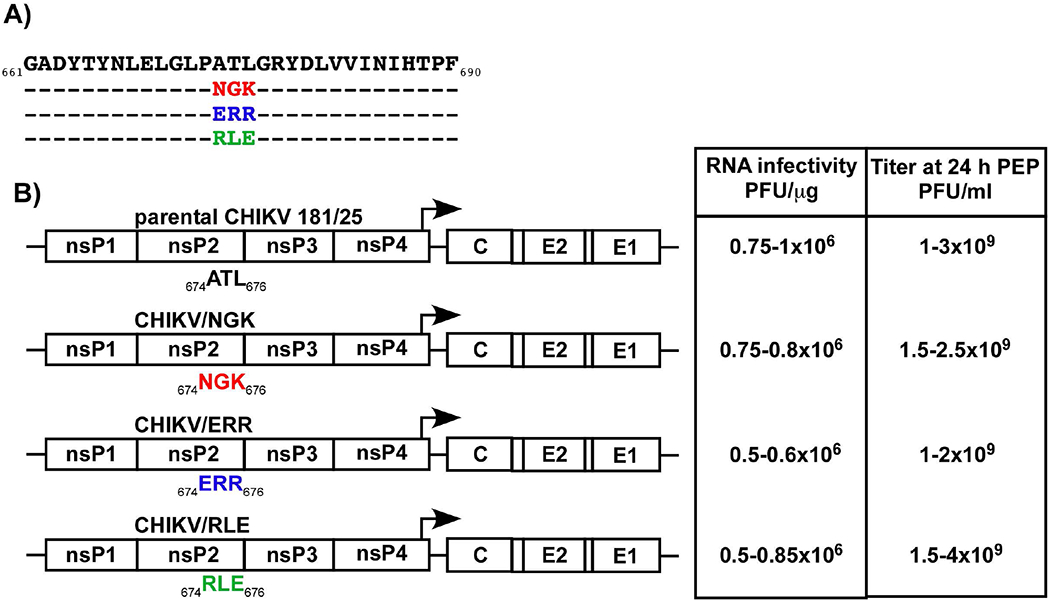
CHIKV 181/25 derivatives with mutated VLoop are viable. (A) The alignment of CHIKV nsP2 fragment containing indicated mutations. Dashes indicate identical aa. The numbers correspond to aa in nsP2 of parental CHIKV 181/25. (B) RNA infectivity and viral titers at 24 h post electroporation. BHK-21 cells were electroporated with 3 μg of in vitro-synthesized RNAs of parental CHIKV 181/25 and the designed mutants. Electroporated cells were used for the infectious center assay (see Materials and Methods for details) and for generating viral stocks. Viral titers were assessed by plaque assay on BHK-21 cells. Transfection experiments were reproducibly repeated three times and the presented values are ranges from three individual experiments.
The designed CHIKV nsP2 mutants replicate in a variety of cell lines.
Next experiments were aimed at comparing replication rates of the designed mutants with those of parental CHIKV 181/25 in the cells of different origins (Fig. 2). Some of the used cell lines, such as human fibroblasts MRC-5, BJ-5ta and mouse NIH 3T3 fibroblasts, are fully competent in type I IFN induction and signaling (see the followng sections). HEK 293 cells were used as a less efficient type I IFN inducer (data not shown), and others, Vero and BHK-21 cells, were applied as cell lines having defects in either type I IFN induction and signaling, respectively. All of the above cell lines were infected at an MOI of 0.01 PFU/cell, and virus release was assessed at different times post infection (PI). CHIKV nsP2 mutants demonstrated efficient replication in all cell types with the highest titers in BHK-21 and HEK 293 cells. However, in the cells competent in type I IFN induction and signaling (BJ-5ta, MRC-5 and NIH 3T3), at the late times PI, final titers of the mutants were reproducibly lower than those of the parental CHIKV 181/25. The detected 50-100-fold decrease in viral titers at 24 h PI was not a result of alterations in either G and SG RNA synthesis or translation of structural proteins. NsP2 mutants and parental CHIKV 181/25 exhibited similar efficiencies of RNA synthesis and translation of structural proteins (Fig. 3). Thus, the plausible explanation for the detected lower titers of the mutants in the experiments performed at low MOI was that in contrast to CHIKV 181/25, they became efficient type I IFN inducers.
FIG. 2.
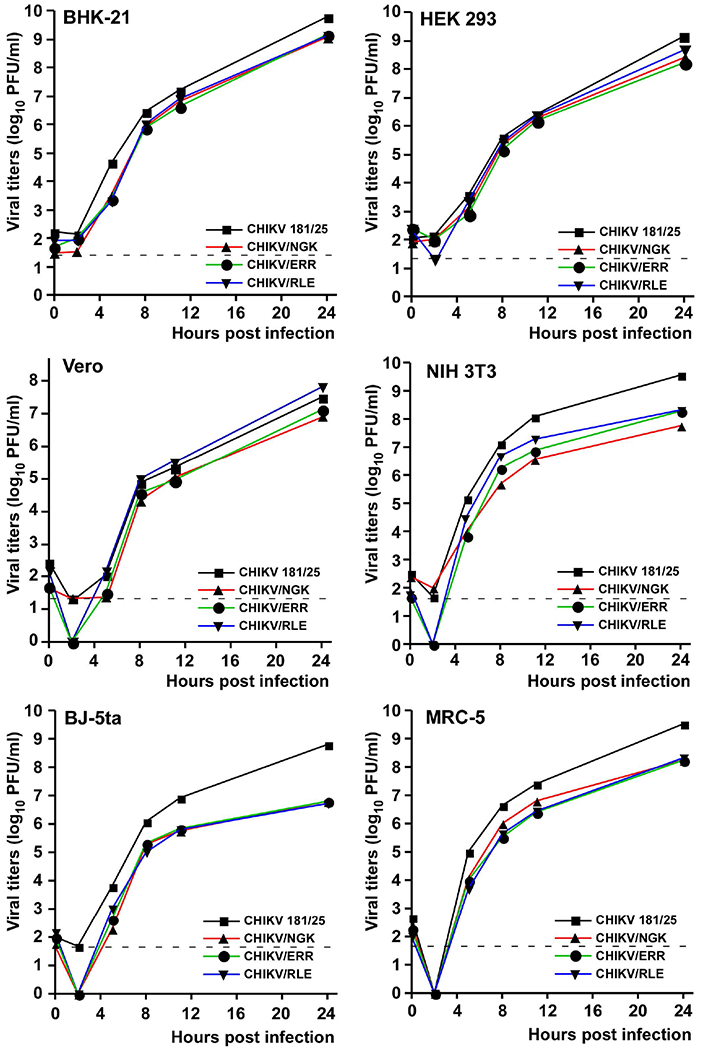
CHIKV nsP2 mutants efficiently replicate in rodent and human cells. 5x105 BHK-21, Vero, NIH 3T3, HEK 293, MRC-5 and BJ-5ta cells in 6-well Costar plates were infected with CHIKV 181/25 or designed mutants at an MOI of 0.01 PFU/cell. At the indicated time points, media were replaced, and viral titers were determined by plaque assay on BHK-21 cells. The experiments were reproducibly repeated 3 times, and the results of one representative experiment are presented.
FIG. 3.
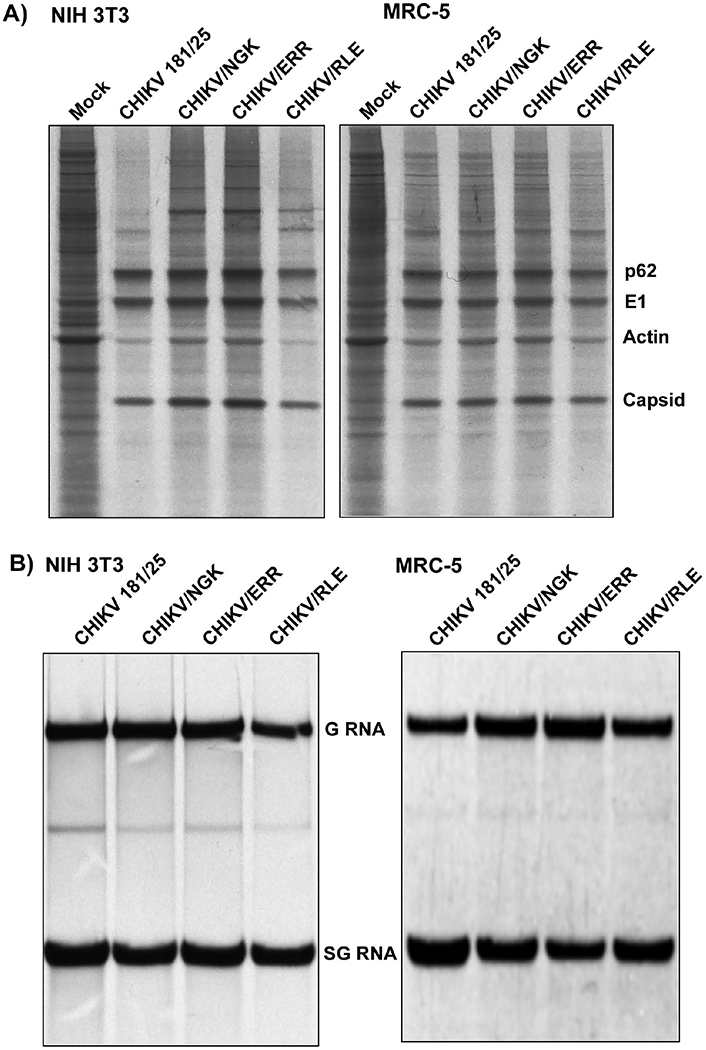
The designed CHIKV nsP2 mutants demonstrate an efficient synthesis of virus-specific RNAs and viral structural proteins. (A) 5x10s cells in the 6-well Costar plate were infected with parental CHIKV 181/25 and designed mutants at an MOI of 20 PFU/cell. At 7 h PI, they were washed with PBS, and proteins were metabolically labeled for 30 min with [35S]methionine (see Materials and Methods for details). Equal amounts of lysates were analyzed by gel electrophoresis in 10% NuPAGE gels (Invitrogen), followed by autoradiography. (B) 5x105 cells in the 6-well Costar plate were infected with the indicated viruses at an MOI of 20 PFU/cell. Virus-specific RNAs were metabolically labeled between 4 and 8 h PI in complete media, supplemented with [3H]uridine (20 μCi/ml) and Actinomycin D (1 μg/ml), then RNAs were isolated and analyzed by agarose gel electrophoresis as described in Materials and Methods.
NsP2-specific mutations make CHIKV a potent IFN-β inducer.
Next, we evaluated the ability of CHIKV nsP2 mutants to induce type I IFN in mouse NIH 3T3 and human MRC-5 and HFF-1 fibroblasts (Fig. 4). Cells were infected with parental CHIKV 181/25 and the designed mutants at high MOI (20 PFU/cell). Media were harvested at 18 h PI, and viral titers and concentrations of the released IFN-β were determined in the same samples. In all of the used cell lines, CHIKV 181/25 induced IFN-β very inefficiently, if at all (Fig. 4), and its concentrations remained at the limit of detection. In repeat experiments, the nsP2 mutants reproducibly replicated to essentially the same titers as the parental CHIKV 181/25 (see the left panels in Fig. 4), but, in contrast, were very potent IFN-β inducers, particularly in MRC-5 cells. Taken together, these results demonstrated that mutations in VLoop altered the interferon-inhibiting effect of nsP2 protein in both mouse and, importantly, in human cells.
FIG. 4.
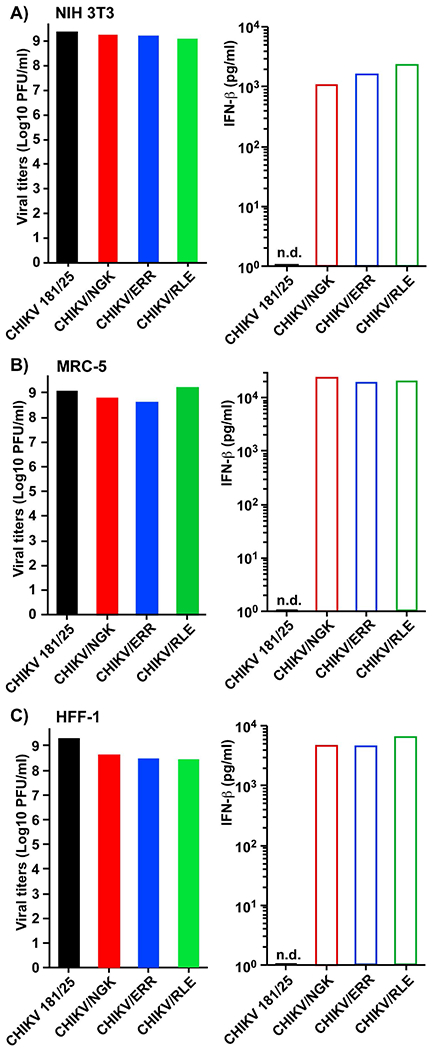
CHIKV nsP2 mutants, but not the parental CHIKV 181/25, are potent inducers of IFN-β in both murine and human cell lines. NIH 3T3 (A), MRC-5 (B), and HFF-1 (C) cells were infected at an MOI of 20 PFU/cell with nsP2 mutants and parental CHIKV 181/25. At 18 h PI, the supernatants were harvested to determine viral titers and the levels of IFN-β. n.d. indicates that the concentration of IFN-β was below the limit of detection. Similar experiments were made multiple times with consistent results. The results of one of the representative experiments are presented.
Consequently, the inability of the viruses to interfere with induction of IFN-β made them incapable of forming plaques in the cell lines having no defects in type I IFN induction and signaling (Fig. 5). On BHK-21 cells, the mutants and parental virus produced readily detectable plaques of similar sizes. In NIH 3T3, MRC-5 and BJ-5ta cells, mutants failed to develop plaques. However, we observed cytopathogenecity in MRC-5 and BJ-5ta cell lines when they were infected at higher MOI by less diluted samples. The most likely explanation for the inability to form plaques was that IFN-β released by primarily infected cells activated the antiviral state in the surrounding cells and protected them against subsequent rounds of infection.
FIG. 5.
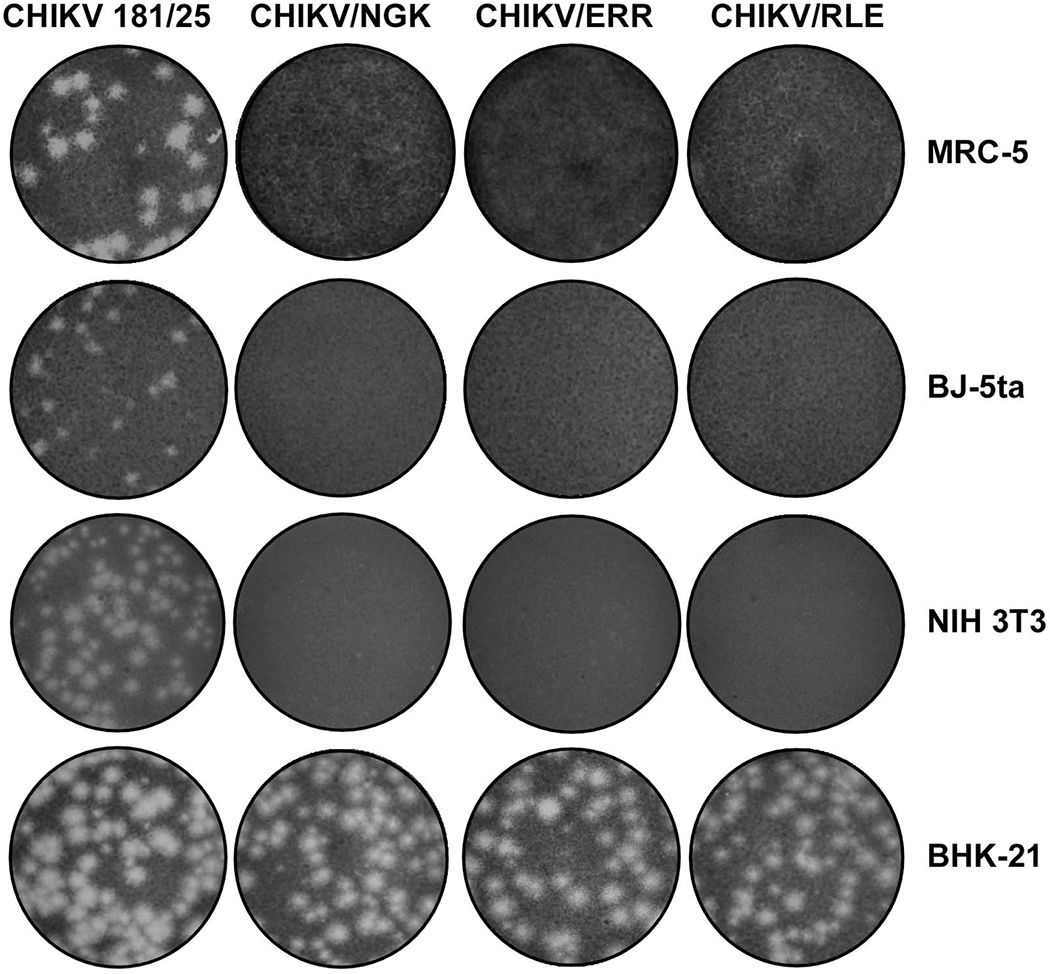
CHIKV nsP2 mutants do not form plaques on the cells competent in type I IFN induction and signaling. CHIKV nsP2 mutants and parental CHIKV 181/25 were used in plaque assay performed on the indicated cell lines. This figure displays wells with monolayers of different cells, which were infected with the same dilutions of the indicated viruses. All of the plates were stained with crystal violet after 3 days of incubation at 37°C
Replication of CHIKV nsP2 mutants results in activation of interferon-stimulated genes (ISGs).
In additional experiments, we tested whether cells infected with the mutants were not only releasing IFN-β, but also remained competent in IFN signaling and ultimate activation of ISGs. NIH 3T3 and MRC-5 cells were infected at an MOI of 20 PFU/cell and, at 16 h PI, the induction of selected ISGs and IFN-β was evaluated by RT-qPCR. Compared to parental CHIKV 181/25, cells infected with the mutants demonstrated a few orders of magnitude more efficient activation of ISGs (Fig. 6). Thus, CHIKV nsP2 mutants were incapable of inhibiting ISG-dependent antiviral response in the cells of both human and mouse origins.
FIG. 6.
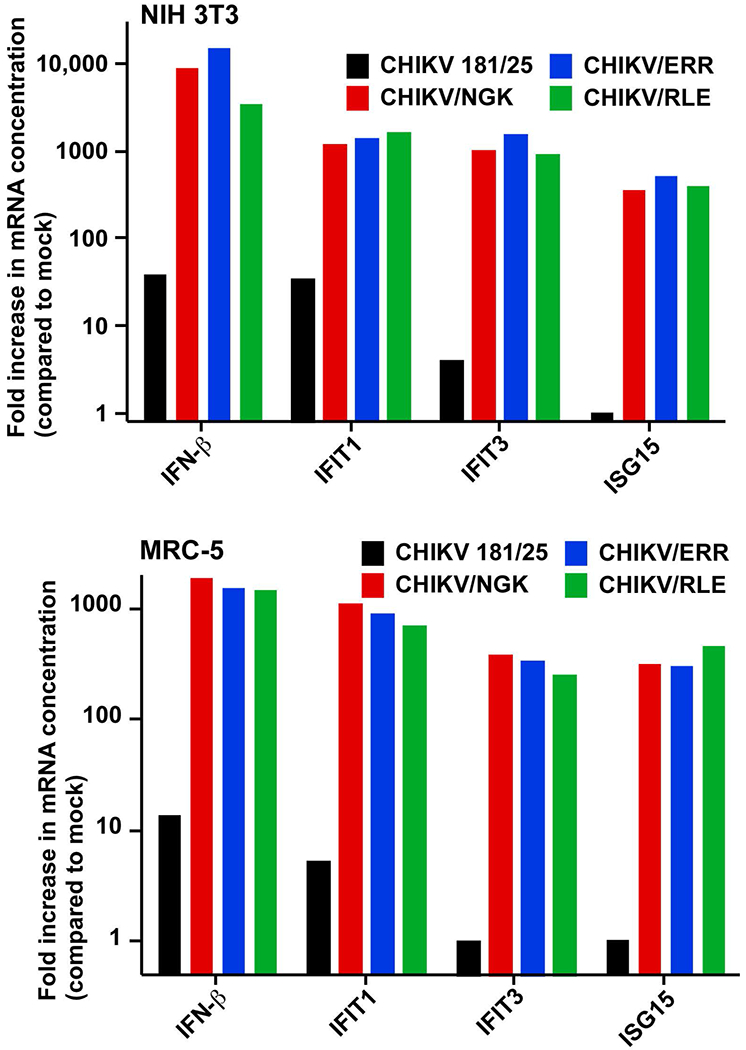
Infections of murine NIH 3T3 and human MRC-5 fibroblasts with CHIKV nsP2 mutants result in ISG activation. NIH 3T3 and MRC-5 cells were infected with the indicated viruses at an MOI of 20 PFU/cell, and, at 16 h PI, the induction of indicated ISGs and IFN-β was evaluated by RT-qPCR as described in Materials and Methods. The fold increase in the ISGs transcript level in virus-infected cells relative to the mock-infected cells were calculated using ΔΔCT method. The experiment was reproducibly repeated three times with similar results, and the data from one representative experiment are shown. Average values from triplicate samples are presented, but the error bars are too small to be visible at this scale.
CHIKV nsP2 mutants remain immunogenic in mice.
Taken together, the accumulated data demonstrated that nsP2 VLoop-specific mutations affected CHIKV 181/25 infection spread in vitro, in the cells having no defects in type I IFN induction and signaling. Infected cells remained capable of efficient type I IFN induction and responded by ISG activation. These characteristics suggested that the introduced mutations could improve the currently available, attenuated strain CHIKV 181/25 in terms of its safety. However, the enhanced attenuation could potentially make it less capable of inducing an adaptive immune response.
Thus, firstly, to understand the effect of the mutations on CHIKV replication in vivo, 2-to-3-week-old C57BL/6 mice were infected with the same doses of parental CHIKV 181/25 and nsP2 mutants in the left footpad. The blood samples were collected on days 1, 2 and 3 PI and tested for levels of viremia. Only two samples taken on days 1 and 2 from CHIKV 181/25-infected mice showed the presence of the virus at the levels of 100 and 50 PFU/ml, respectively (data not shown). In all other mice, the levels of viremia caused by either parental virus or the mutants were below the limit of detection. We monitored swelling of the joints or weight loss that are indications of morbidity, but in all groups, no significant changes were detected (data not shown). Thus, these experiments did not generate direct, conclusive data about changes in replication levels of the CHIKV 181/25-derived viruses with mutated nsP2 in vivo.
To confirm replication of the mutants and their immunogenicity if any, we collected blood samples on day 21 PI and tested them for the levels of neutralizing antibodies (see Materials and Methods for details). The results demonstrated that mutants remained competent in replication in vivo. They induced readily detectable levels of CHIKV-specific, neutralizing antibodies, albeit less efficiently than the parental CHIKV181/25 (Fig. 7A). This was an indirect indication that viral replication in vivo was affected. At day 25 PI, the immunized mice were also challenged with a more pathogenic variant of CHIKV, wCHIKV (see Materials and Methods for details), to show the protective effect of vaccination. Blood samples were collected on days 1, 2, and 3 post challenge to assess the levels of viremia. In the unimmunized mice (PBS group), wCHIKV induced high levels of viremia that remained detectable on days 2 and 3 (Fig. 7B). Only two mice immunized with CHIKV/NGK demonstrated low viremia on day 1 post challenge, as well as did one mouse immunized with CHIKV 181/25 on day 2. No infectious virus was detected in mice immunized with CHIKV/ERR and CHIKV/RLE at any time post challenge. Thus, the designed CHIKV 181/25-based mutants remained immunogenic and offered protection from wCHIKV infection.
FIG. 7.
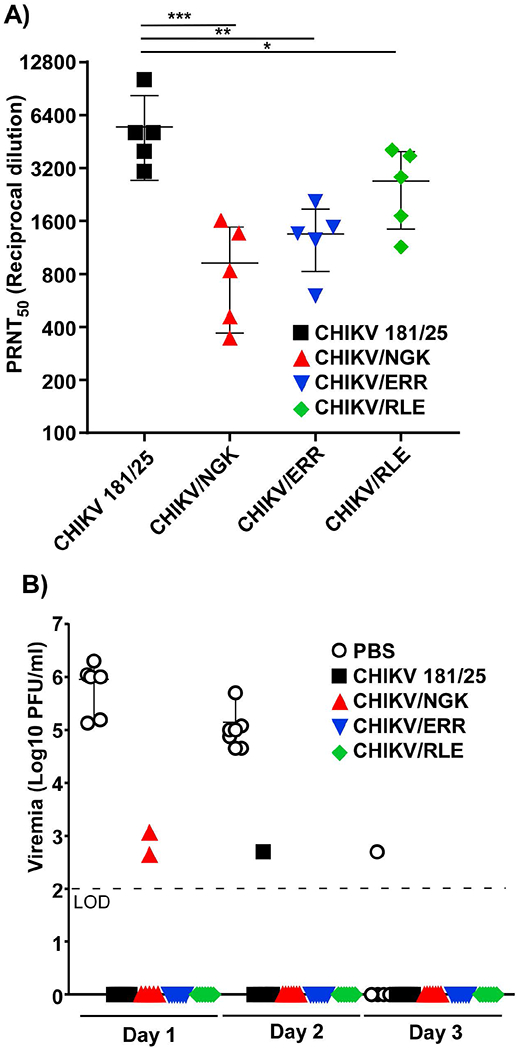
The designed CHIKV 181/25-based nsP2 mutants remain immunogenic and protect mice against following challenge with wCHIKV. Two-to-three-week old C57BL/6 mice (n = 6/group) were infected in the left footpad with 5x103 PFU of CHIKV 181/25 and its indicated nsP2 mutants. (A) The levels of neutralizing Abs were assessed at day 21 PI as described in Materials and Methods. Results are presented as means with standard deviations. Significances of differences among the values were determined by one-way ANOVA, followed by Dunnett’s multiple comparisons test. They are indicated by asterisks as follows: *, P<0.05; **, P<0.01; ***, P<0.001. CHIKV181/25 is compared to other groups. (B) Mice were challenged on day 25 PI with 105 PFU of wCHIKV (see Materials and Methods for details) using the same route of infection. Blood samples were collected on days 1, 2, and 3, and levels of viremia were assessed by plaque assay on BHK-21 cells. Each data point represents a value from an individual mouse. The dashed line indicates the limit of detection (LOD) in the plaque assay.
NsP2-specific mutations attenuate wCHIKV replication in vivo.
In order to generate better data about the effects of VLoop replacements on viral replication in vivo, we cloned the above-described mutant VLoop-encoding sequences into the genome of pathogenic wCHIKV (see Materials and Methods for details). The latter virus was used in challenge experiments described in the previous section. The designed variants were termed wCHIKV/NGK, wCHIKV/ERR, and wCHIKV/RLE. These viruses and parental wCHIKV were rescued by transfecting the plasmids containing cDNAs of viral genomes under control of the CMV promoter (see Materials and Methods for details). Two-to-three-week-old C57BL/6 mice were infected with the same dose, 5x103 PFU, of the rescued viruses. Since the differences in viremia levels correlate most efficiently with the differences in CHIKV pathogenicities (8), we assessed the induced viremia on days 1, 2 and 3 PI (Fig. 8A). On day 1, mice infected with parental wCHIKV exhibited viremia at the level of 106 PFU/ml, and it continued on day 2 PI. At day 3, viremia above the level of detection was found in one mouse. Mice infected with wCHIKV also demonstrated the delay in gaining weight (Fig. 8B). Whereas, the designed nsP2 mutants developed almost 3 orders of magnitude lower viremia even on day 1 (Fig. 8A), and only 2 mice infected with wCHIKV/NGK remained positive for viremia on day 2. In other samples collected on days 2 and 3, the presence of the viruses was below the limit of detection. Mice infected with the mutants gained weight more efficiently than those in wCHIKV-infected group (Fig. 8B). Thus, the modifications in VLoop had strong negative effects on the ability of wCHIKV to develop viremia in a mouse model.
FIG. 8.
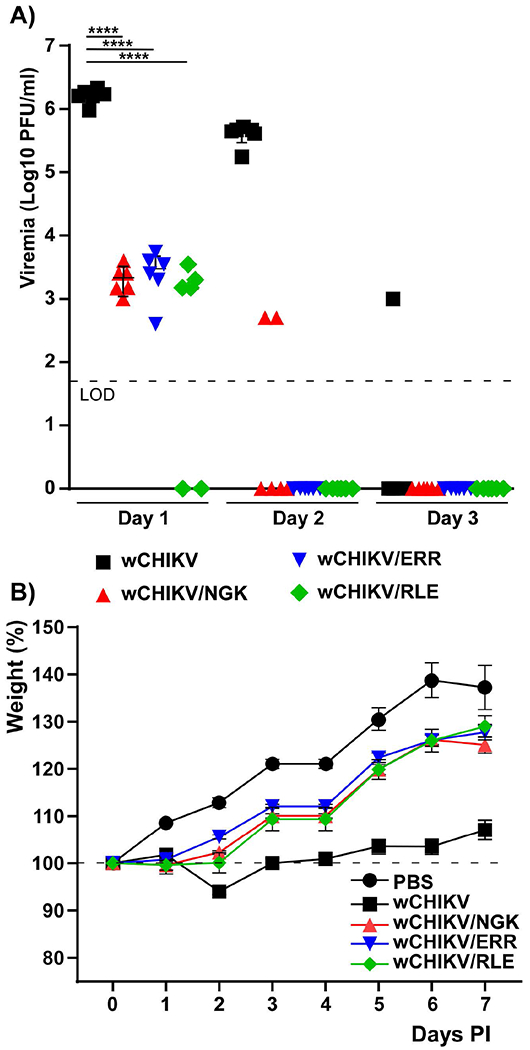
Mutations in nsP2 of wCHIKV strongly affect the development of viremia in mice. (A) Two-to-three-week old C57BL/6 mice (n = 6/group) were infected in the left footpad with 5x103 PFU of wCHIKV nsP2 mutants and parental wCHIKV. Blood samples were taken on days 1, 2 and 3 PI, and the levels of viremia were assessed by plaque assay on BHK-21 cells. The dashed line indicates the limit of detection (LOD). Results are presented as means with standard deviations and significant differences, determined by one-way ANOVA, followed by Tukey’s multiple comparisons test. They are indicated by asterisks as follows: ****, P<0.0001. wCHIKV is compared to other groups. (B) Weight change post infection with indicated viruses. Results are presented as means with standard deviations.
Additional CHIKV attenuation by mutations in the macro domain of nsP3.
The nsP2 mutants, which were developed on the bases of either CHIKV 181/25 or wCHIKV, demonstrated dramatically lower cytopathogenicity in mouse cells, if any, and induced lower viremia in mice. However, we were concerned that the designed recombinant viruses retained cytopathogenicity in the tested cell lines of human origin. In contrast to NIH 3T3 cells, at the MOIs higher than 1 PFU/cell, human cells were slowly developing complete CPE. This was an indication that in contrast to mouse fibroblasts, in human cells, ISG activation (Fig. 6) by virus-induced type I IFN was insufficient for preventing cell death and virus clearance. Therefore, we explored additional means of CHIKV attenuation by introducing mutations into nsP3 macro domain. As in our previous studies of the mechanism responsible for the SINV-induced cytopathic effect (4), N24T and N24A/D32G mutations were aimed to inactivate the nsP3 macro domain-associated mono-ADP-ribosylhydrolase activity without compromising viral replication rates (17). In other studies, alterations of this nsP3 macro domain-specific function affected CHIKV pathogenesis (47). N24T and N24A/D32G substitutions were introduced into genomes of both CHIKV/NGK/GFP (Fig. 9A) and wCHIKV/NGK, which already had the nsP2-specific VLoop replaced. In CHIKV 181/25-based constructs, GFP was left under control of the subgenomic promoter to better monitor viral replication in the absence of obvious CPE development.
FIG. 9.
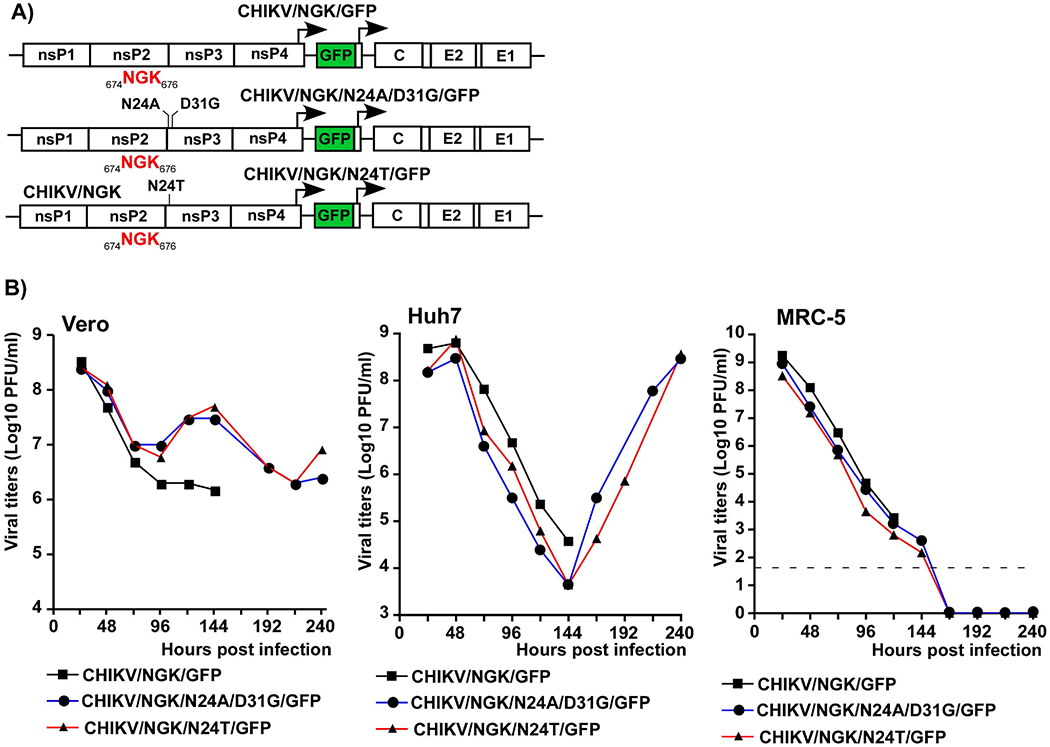
Additional mutations in the macro domain of nsP3 in CHIKV/NGK/GFP reduce viral cytopathogenicity in human and Vero cells. (A) The schematic presentation of the genomes of recombinant viruses. (B) 5x105 cells of the indicated cell lines in 6-well Costar plates were infected with the mutants at an MOI of 20 PFU/cell. Media were replaced at the indicated time points, and cells were split upon reaching confluency. Viral titers were determined by plaque assay on BHK-21 cells. The dashed line indicates the limit of detection (LOD).
The newly designed CHIKV 181/25-based nsP2/nsP3 mutants, CHIKV/NGK/N24A/D31G/GFP and CHIKV/NGK/N24T/GFP (Fig. 9A), exhibited remarkably reduced cytopathogenicity. Unlike the parental CHIKV/NGK/GFP, they could not even form clear plaques in BHK-21 cells under agarose cover (data not shown). These mutants were also able to persistently replicate in Vero and Huh7 cells, which are deficient in type I IFN response (Fig. 9B), while the parental CHIKV/GFP and CHIKV/NGK/GFP variants were causing complete CPE within 2-3 (data not shown) and 5-6 (Fig. 9B) days PI, respectively. Interestingly, the persistence of CHIKV/NGK/N24A/D31G/GFP and CHIKV/NGK/N24T/GFP in Huh7 cells developed in an unusual manner. In replicate experiments, a few days PI, these cells accelerated growth, and the mutants also demonstrated higher levels of replication. This was suggestive of viral adaptation/selection; however, further investigation of this phenomenon was beyond the scope of this study. In contrast to Vero and Huh7 cells, the IFN competent human MRC-5 fibroblasts were able to stop and clear the established replication of nsP2/nsP3 mutants (Fig. 9B), while essentially all cell infected with parental CHIKV/NGK/GFP were non-viable by day 5 PI.
The described above nsP3 mutations were also introduced into the genome of wCHIKV/NGK (Fig. 10A). The designed wCHIKV/NGK/N24A/D31G and wCHIKV/NGK/N24T variants were rescued and used for in vivo study (Fig. 10B). Two-to-three-week-old C57BL/6 mice were infected with equal doses (5x103 PFU) of nsP2/nsP3 mutants or parental wCHIKV and wCHIKV/NGK in the left footpad. In this experiment (Fig. 10B), wCHIKV showed the highest level of viremia, which was ~106 PFU/ml on day 1, then decreased to ~105 PFU/ml on day 2, and dropped to the lowest level of detection on day 3. For all of the mutants, viremia on day 1 was more than 3 orders of magnitude lower and below the detection threshold on the subsequent days. Similar levels of viremia induced by nsP2 and nsP2/3 mutants also suggested that mutations in nsP3 had no negative effects on viral replication in mice.
FIG. 10.
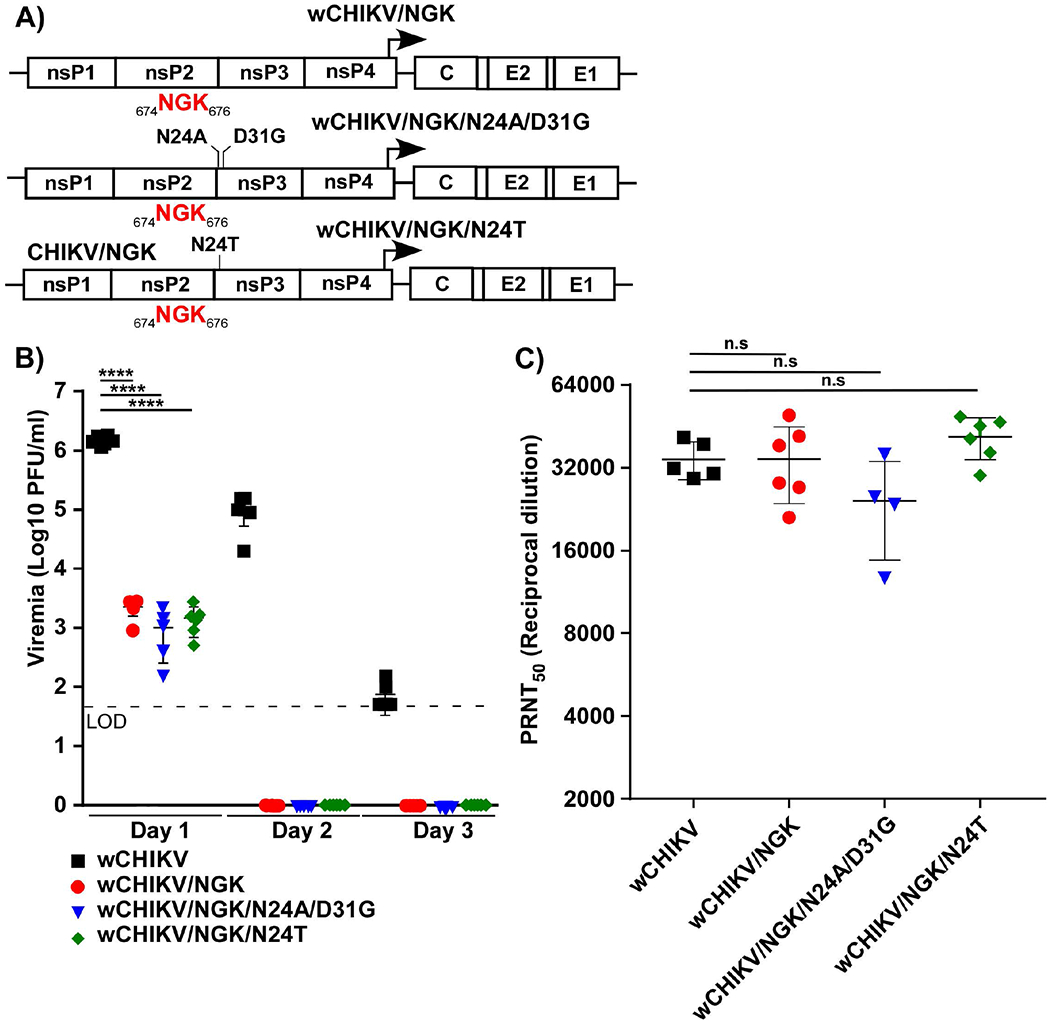
Mutations in the macro domain of nsP3 in wCHIKV/NGK variant have no negative effect on viral replication in mice. (A) The schematic presentation of the recombinant genomes. (B) Two-to-three-week old C57BL/6 mice (n = 6/group) were infected in the left footpad with 5x103 PFU of the indicated mutants and parental wCHIKV. Blood samples were collected on days 1, 2, and 3 PI to analyze the levels of viremia. The dashed line indicates the limit of detection (LOD). Results are presented as means with standard deviations and significant differences, determined by one-way ANOVA, followed by Tukey’s multiple comparisons test. wCHIKV is compared to other groups. **** indicates P<0.0001 (C) Titers of neutralizing antibodies were evaluated on day 21 PI. Results are presented as means with standard deviations. Values are not significantly different, as determined by one-way ANOVA, followed by Dunnett’s multiple comparisons test. P>0.05.
Despite 1000-fold lower and shorter viremia, the nsP2 and nsP2/nsP3 mutants induced neutralizing Abs with the efficiencies similar to that of the parental wCHIKV (Fig. 10C). wCHIKV/NGK/N24A/D31G and wCHIKV/NGK/N24T variants, which demonstrated an additional reduction in cytopathogenicity in human cells, remained as immunogenic as the parental wCHIKV/NGK.
DISCUSSION
To date, live attenuated viral vaccines remain desirable due to their efficient induction of protective immunity against viral infections. The most common approach in the development of live attenuated vaccines is the serial passage of the wt viruses either in cultured cells or in chicken embryos (7, 12, 13, 44). Such passaging of alphaviruses usually leads to an accumulation of mutations in viral structural proteins and, in some cases, in the promoter of G RNA located in the 5’UTR (27, 37, 38). Mutations in E2 glycoprotein may make viral spikes capable of more efficient interaction with heparan sulfate at the plasma membrane (8, 27, 39). They increase alphavirus infectivity during propagation in cultured cells (8). Furthermore, the 5’UTR-specific mutations destabilize the RNA secondary structure (40, 41) and release the very 5’-terminal nucleotides from the stems, which are predicted for both 5’UTR of G RNA and the 3’end of the negative strand RNA intermediate. These structural changes improve the rates of G RNA replication and likely translation of nsPs (41). However, they also make evolved alphaviruses more sensitive to the antiviral effect of one of the ISG products, IFIT1 (32, 54), and thus, contribute to their attenuation. The passaging-based approach has previously been applied for the development of attenuated VEEV and CHIKV variants, TC-83 and 181/25 strains, respectively (7, 45). The attenuated phenotypes of the selected CHIKV and VEEV mutants rely on only two point mutations (27, 37), and both viruses remain capable of causing adverse effects in some vaccinees (18, 53). Thus, in the case of CHIKV and VEEV, application of passaging-based approach had likely reached its limit; however, the developed strains, VEEV TC-83 and CHIKV 181/25, remained insufficiently attenuated. Nevertheless, they did become stable upon propagation in tissue culture, demonstrated significant attenuation and may be used for further improvement of their safety.
Interference with the development of the innate immune response is a common characteristic of many viral taxonomic groups (67). Alphaviruses are not an exception and have developed the abilities to downregulate cellular response to their replication and to inhibit cell signaling that is aimed at the establishment of the antiviral state in yet uninfected cells (25). Some of the alphaviruses, including CHIKV, induce type I IFN very inefficiently if at all (14) (Fig. 4). As do most of the positive sense RNA viruses, alphaviruses isolate their dsRNA intermediates into membrane spherules (22). This likely complicates sensing of these pathogen-associated molecular patterns (PAMPs) by cytoplasmic receptors (pattern recognition receptors, PRRs), such as RIG-I, MDA5 and PKR (3). However, this isolation appears to be incomplete, and some of the viral mutants that demonstrate no alterations in spherule formation become potent type I IFN inducers (21, 26). Moreover, alphavirus RCs can utilize cellular mRNA as templates for dsRNA synthesis (51). These dsRNA molecules may be included into spherules less efficiently and be also detected by cellular PRRs.
Consequently, besides the membrane spherule formation, alphaviruses employ another powerful mechanism of interfering with the induction of antiviral response. Geographically isolated viral species induce robust transcriptional shutoff in vertebrate, but not in mosquito cells, despite using very different means of achieving this goal (25). In case of OW alphaviruses, including CHIKV, inhibition of transcription is mediated by the nonstructural protein nsP2. A large fraction of nsP2 accumulates in the nucleus (6, 23), and within 4 h PI, presence of RPB1, the catalytic subunit of cellular DNA-dependent RNA polymerase II, drops to undetectable levels (5, 6). Expression of CHIKV or SINV nsP2 proteins alone has deleterious effect on the overall cellular transcription and ultimately causes cell death (24). Thus, alterations of the nuclear functions of CHIKV nsP2 could make virus i) less cytopathic, ii) transform it into a potent type I IFN inducer, iii) attenuate viral infection in vivo and iv) improve the safety of already available, attenuated strain CHIKV 181/25. These possibilities were supported by the results of our previous studies, in which we designed recombinant VEE/CHIKV variants encoding VEEV-specific nsPs and CHIKV structural proteins (34, 62, 63). The distinguishing characteristic of the latter viruses was that they expressed no viral proteins with transcription inhibitory functions and demonstrated very attenuated phenotypes in mice, but remained immunogenic. Similarly, in other studies, VEEV TC-83 and EEEV FL93 viruses were designed to have mutations in the nuclear localization signals of their capsid proteins (1, 11). Those modifications made capsids incapable of forming tetrameric complexes with CRM1 and importin-α/β and blocking nuclear pores (9, 10). Consequently, viral mutants were also no longer able to inhibit cellular transcription and became attenuated in vivo. Taken together, these data suggested that alphavirus-specific nuclear functions play critical roles in viral pathogenesis, and thus, CHIKV nsP2 can be exploited as a target for mutations aimed at viral attenuation. However, modifications of nsP2 to make it incapable of interfering with nuclear functions is a more delicate task than introducing mutations into the RNA-binding domain of VEEV or EEEV capsid proteins. Such point mutations are well tolerated by the highly variable, disordered, positively charged, RNA-binding domain of capsid protein (11). NsP2, in contrast, exhibits a variety of enzymatic functions in viral RNA synthesis. Their alteration by mutagenesis may either have deleterious effects on viral RNA replication (60) or be lethal for the virus.
In the recent study, we have identified a small peptide on the surface of the C-terminal domain of the OW nsP2 (VLoop) that can be modified without affecting protease, helicase or other protein’s functions (4, 6). Here, the replacements of VLoop in CHIKV 181/25 by selected heterologous peptides affected only the nuclear function(s) of nsP2 without having any negative effects on viral replication in the cells with defects in type I IFN induction or signaling (Fig. 2). In IFN-competent mouse and, importantly, human cells, the designed CHIKV 181/25 variants, but not the parental CHIKV 181/25, were capable of inducing very high levels of IFN-β (Fig. 4). The infected cells also remained able to respond to IFN-β release by activating ISGs (Fig. 6). Most importantly, CHIKV 181/25 mutants remained immunogenic, and the levels of neutralizing Abs were comparable to those induced by parental CHIKV 181/25 (Fig. 7A). This was an indication that new mutations did not make virus overattenuated.
The same replacements of nsP2-specific VLoop in the more pathogenic wCHIKV variant decreased viral replication in vivo (Figs 8A and 10B). On day 1 PI, the levels of viremia developed by wCHIKV/NKG, wCHICKV/ERR, and wCHIKV/RLE were lower than that of parental wCHIKV by 1000-fold. Interestingly, despite 3 orders of magnitude lower and very short viremia, wCHIKV nsP2 mutants induced very high levels of neutralizing Abs. Most likely, as it was described for VEEV replicons (15), the lack of transcription inhibitory functions made these mutants potent inducers of the cytokines, most importantly IFN-β. Their release may have stimulatory effect on the antibody response. This was likely the case also for CHIKV 181/25-based mutants because they also induced readily detectable levels of neutralizing Abs after a single vaccination of mice.
A distinguishing characteristic of alpha- and other RNA+ viruses is the high rate of their evolution (34). Viruses containing point mutations that affect replication are highly unstable. Their passaging in cultured cells leads to rapid generation and selection of more efficiently replicating variants, which usually accumulate either true reverting or second site mutations. The essentially wt levels of replication of the newly designed CHIKV nsP2 mutants in vitro and the replacements of the entire VLoop peptide instead of making point mutations suggested that reversion of the mutants to parental phenotype is a less probable event. Importantly, the original strain CHIKV 181/25 is already highly attenuated and so far, there is no indication that it can cause persistent arthritis. Therefore, in the unlikely case that the nsP2 mutations revert to the CHIKV 181/25-specific sequence, this will not result in the generation of pathogenic wild type CHIKV. The reversion of all of the nsP2- and E2-specific mutations at the same time to produce a natural strain of CHIKV is an even less likely event.
Since mice are not an adequate animal model for CHIK fever, the possibility that designed CHIKV 181/25 nsP2 mutants will be capable of inducing adverse effects in humans cannot be completely ruled out. Moreover, the nsP2 mutants were noncytopathic in mouse cells but remained cytopathic in human cell lines. However, previously, we found that to become noncytopathic, SINV nsP2 mutants required additional modifications in the macro domain of nsP3, which altered its mono-ADP-ribosylhydrolase activity and virus-induced translational shutoff (4). In this study, such nsP3 macrodomain-specific mutations also affected the cytopathogenicity of CHIKV in human cells without deleterious effects on viral replication rates (Fig. 9). As expected, these mutations also did not alter replication of wCHIKV nsP2 mutants, because they had been designed to affect virus-induced cell death, but not the efficiency of its replication. Such mutations in nsP3 can be likely applied for additional attenuation of CHIKV. However, their effects CHIKV-induced pathologies need better experimental support. Moreover, based on our previous studies of the NW and chimeric alphaviruses that exhibit no nuclear functions, the described modifications in nsP2 are likely sufficient for the development of safer alternatives of CHIKV 181/25.
In conclusion, the results of this study demonstrate that i) CHIKV-specific nsP2 can be modified to make the virus incapable of inhibiting transcriptional shutoff. ii) They make CHIKV a potent type I IFN inducer in mouse and human cells without affecting its in vitro replication rates. iii) The introduced mutations have a negative effect on the levels of viremia caused by pathogenic variant wCHIKV. iv) Both CHIKV 181/25 and wCHIKV nsP2 mutants remain capable of inducing neutralizing Abs. v) If necessary, CHIKV can be additionally modified through the introduction of the selected mutations into the macro domain of nsP3 to alter its mono-ADP-ribosylhydrolase function. Thus, CHIKV attenuation can be achieved through a rational design of mutations in its nonstructural genes. This rationale can improve attenuation, safety, and stability of CHIKV variants attenuated by other approaches. Importantly, similar VLoop mutants can be rapidly developed for other pathogenic OW alphaviruses.
ACKNOWLEDGMENTS
We thank Scott Weaver for providing infectious cDNA clone of CHIKV 181/25. We also thank Valeriya Kuznetsova for technical assistance.
This study was supported by Public Health Service grants R01AI133159 and R01AI118867 to E.I.F., and R21AI119627 to I.F.
REFERENCES
- 1.Aguilar PV, Leung LW, Wang E, Weaver SC, and Basler CF. 2008. A five-amino-acid deletion of the eastern equine encephalitis virus capsid protein attenuates replication in mammalian systems but not in mosquito cells. J Virol 82:6972–6983. [DOI] [PMC free article] [PubMed] [Google Scholar]
- 2.Ahola T, and Kaariainen L. 1995. Reaction in alphavirus mRNA capping: formation of a covalent complex of nonstructural protein nsP1 with 7-methyl-GMP. Proc Natl Acad Sci U S A 92:507–511. [DOI] [PMC free article] [PubMed] [Google Scholar]
- 3.Akhrymuk I, Frolov I, and Frolova EI. 2016. Both RIG-I and MDA5 detect alphavirus replication in concentration-dependent mode. Virology 487:230–241. [DOI] [PMC free article] [PubMed] [Google Scholar]
- 4.Akhrymuk I, Frolov I, and Frolova EI. 2018. Sindbis Virus Infection Causes Cell Death by nsP2-Induced Transcriptional Shutoff or by nsP3-Dependent Translational Shutoff. J Virol 92. [DOI] [PMC free article] [PubMed] [Google Scholar]
- 5.Akhrymuk I, Kulemzin SV, and Frolova EI. 2012. Evasion of the innate immune response: the Old World alphavirus nsP2 protein induces rapid degradation of Rpb1, a catalytic subunit of RNA polymerase II. J Virol 86:7180–7191. [DOI] [PMC free article] [PubMed] [Google Scholar]
- 6.Akhrymuk I, Lukash T, Frolov I, and Frolova EI. 2019. Novel Mutations in nsP2 Abolish Chikungunya Virus-Induced Transcriptional Shutoff and Make the Virus Less Cytopathic without Affecting Its Replication Rates. J Virol 93. [DOI] [PMC free article] [PubMed] [Google Scholar]
- 7.Alevizatos AC, McKinney RW, and Feigin RD. 1967. Live, attenuated Venezuelan equine encephalomyelitis virus vaccine. I. Clinical effects in man. Am J Trop Med Hyg 16:762–768. [PubMed] [Google Scholar]
- 8.Ashbrook AW, Burrack KS, Silva LA, Montgomery SA, Heise MT, Morrison TE, and Dermody TS. 2014. Residue 82 of the Chikungunya virus E2 attachment protein modulates viral dissemination and arthritis in mice. J Virol 88:12180–12192. [DOI] [PMC free article] [PubMed] [Google Scholar]
- 9.Atasheva S, Fish A, Fornerod M, and Frolova EI. 2010. Venezuelan equine Encephalitis virus capsid protein forms a tetrameric complex with CRM1 and importin alpha/beta that obstructs nuclear pore complex function. J Virol 84:4158–4171. [DOI] [PMC free article] [PubMed] [Google Scholar]
- 10.Atasheva S, Garmashova N, Frolov I, and Frolova E. 2008. Venezuelan equine encephalitis virus capsid protein inhibits nuclear import in Mammalian but not in mosquito cells. J Virol 82:4028–4041. [DOI] [PMC free article] [PubMed] [Google Scholar]
- 11.Atasheva S, Kim DY, Frolova EI, and Frolov I. 2015. Venezuelan equine encephalitis virus variants lacking transcription inhibitory functions demonstrate highly attenuated phenotype. J Virol 89:71–82. [DOI] [PMC free article] [PubMed] [Google Scholar]
- 12.Barrett AD 2001. Current status of flavivirus vaccines. Ann N Y Acad Sci 951:262–271. [DOI] [PubMed] [Google Scholar]
- 13.Berge TO, Banks IS, and Tigertt WD. 1961. Attenuation of Venezuelan equine encephalomyelitis virus by in vitro cultivation in guinea pig heart cells. Am. J. Hyg 73:209–218. [Google Scholar]
- 14.Burke CW, Gardner CL, Stefan JJ, Ryman KD, and Klimstra WB. 2009. Characteristics of alpha/beta interferon induction after infection of murine fibroblasts with wild-type and mutant alphaviruses. Virology 395:121–132. [DOI] [PMC free article] [PubMed] [Google Scholar]
- 15.Carroll TD, Matzinger SR, Barro M, Fritts L, McChesney MB, Miller CJ, and Johnston RE. 2011. Alphavirus replicon-based adjuvants enhance the immunogenicity and effectiveness of Fluzone (R) in rhesus macaques. Vaccine 29:931–940. [DOI] [PMC free article] [PubMed] [Google Scholar]
- 16.Das PK, Merits A, and Lulla A. 2014. Functional cross-talk between distant domains of chikungunya virus non-structural protein 2 is decisive for its RNA-modulating activity. J Biol Chem 289:5635–5653. [DOI] [PMC free article] [PubMed] [Google Scholar]
- 17.Eckei L, Krieg S, Butepage M, Lehmann A, Gross A, Lippok B, Grimm AR, Kummerer BM, Rossetti G, Luscher B, and Verheugd P. 2017. The conserved macrodomains of the non-structural proteins of Chikungunya virus and other pathogenic positive strand RNA viruses function as mono-ADP-ribosylhydrolases. Sci Rep 7:41746. [DOI] [PMC free article] [PubMed] [Google Scholar]
- 18.Edelman R, Tacket CO, Wasserman SS, Bodison SA, Perry JG, and Mangiafico JA. 2000. Phase II safety and immunogenicity study of live chikungunya virus vaccine TSI-GSD-218. Am J Trop Med Hyg 62:681–685. [DOI] [PubMed] [Google Scholar]
- 19.Fayzulin R, and Frolov I. 2004. Changes of the secondary structure of the 5’ end of the Sindbis virus genome inhibit virus growth in mosquito cells and lead to accumulation of adaptive mutations. J Virol 78:4953–4964. [DOI] [PMC free article] [PubMed] [Google Scholar]
- 20.Frolov I, Agapov E, Hoffman TA Jr., Pragai BM, Lippa M, Schlesinger S, and Rice CM. 1999. Selection of RNA replicons capable of persistent noncytopathic replication in mammalian cells. J. Virol 73:3854–3865. [DOI] [PMC free article] [PubMed] [Google Scholar]
- 21.Frolova EI, Fayzulin RZ, Cook SH, Griffin DE, Rice CM, and Frolov I. 2002. Roles of nonstructural protein nsP2 and Alpha/Beta interferons in determining the outcome of Sindbis virus infection. J Virol 76:11254–11264. [DOI] [PMC free article] [PubMed] [Google Scholar]
- 22.Frolova EI, Gorchakov R, Pereboeva L, Atasheva S, and Frolov I. 2010. Functional Sindbis virus replicative complexes are formed at the plasma membrane. J Virol 84:11679–11695. [DOI] [PMC free article] [PubMed] [Google Scholar]
- 23.Fros JJ, Liu WJ, Prow NA, Geertsema C, Ligtenberg M, Vanlandingham DL, Schnettler E, Vlak JM, Suhrbier A, Khromykh AA, and Pijlman GP. 2010. Chikungunya virus nonstructural protein 2 inhibits type I/II interferon-stimulated JAK-STAT signaling. J Virol 84:10877–10887. [DOI] [PMC free article] [PubMed] [Google Scholar]
- 24.Garmashova N, Gorchakov R, Frolova E, and Frolov I. 2006. Sindbis virus nonstructural protein nsP2 is cytotoxic and inhibits cellular transcription. J Virol 80:5686–5696. [DOI] [PMC free article] [PubMed] [Google Scholar]
- 25.Garmashova N, Gorchakov R, Volkova E, Paessler S, Frolova E, and Frolov I. 2007. The Old World and New World alphaviruses use different virus-specific proteins for induction of transcriptional shutoff. J Virol 81:2472–2484. [DOI] [PMC free article] [PubMed] [Google Scholar]
- 26.Gorchakov R, Frolova E, Sawicki S, Atasheva S, Sawicki D, and Frolov I. 2008. A new role for ns polyprotein cleavage in Sindbis virus replication. J Virol 82:6218–6231. [DOI] [PMC free article] [PubMed] [Google Scholar]
- 27.Gorchakov R, Wang E, Leal G, Forrester NL, Plante K, Rossi SL, Partidos CD, Adams AP, Seymour RL, Weger J, Borland EM, Sherman MB, Powers AM, Osorio JE, and Weaver SC. 2012. Attenuation of Chikungunya virus vaccine strain 181/clone 25 is determined by two amino acid substitutions in the E2 envelope glycoprotein. J Virol 86:6084–6096. [DOI] [PMC free article] [PubMed] [Google Scholar]
- 28.Griffin DE 1986. Alphavirus Pathogenesis and Immunity, p. 209–250. In M. S. S. a. Schlesinger J (ed.), The Togaviridae and Flaviviridae. Plenum Press, New York. [Google Scholar]
- 29.Griffin DE 1989. Molecular pathogenesis of Sindbis virus encephalitis in experimental animals. Adv. Virus Res 36:255–271. [DOI] [PubMed] [Google Scholar]
- 30.Hanawalt PC, and Spivak G. 2008. Transcription-coupled DNA repair: two decades of progress and surprises. Nat Rev Mol Cell Biol 9:958–970. [DOI] [PubMed] [Google Scholar]
- 31.Hawman DW, Carpentier KS, Fox JM, May NA, Sanders W, Montgomery SA, Moorman NJ, Diamond MS, and Morrison TE. 2017. Mutations in the E2 Glycoprotein and the 3’ Untranslated Region Enhance Chikungunya Virus Virulence in Mice. J Virol. [DOI] [PMC free article] [PubMed] [Google Scholar]
- 32.Hyde JL, Gardner CL, Kimura T, White JP, Liu G, Trobaugh DW, Huang C, Tonelli M, Paessler S, Takeda K, Klimstra WB, Amarasinghe GK, and Diamond MS. 2014. A viral RNA structural element alters host recognition of nonself RNA. Science 343:783–787. [DOI] [PMC free article] [PubMed] [Google Scholar]
- 33.Karpe YA, Aher PP, and Lole KS. 2011. NTPase and 5’-RNA triphosphatase activities of Chikungunya virus nsP2 protein. PLoS ONE 6:e22336. [DOI] [PMC free article] [PubMed] [Google Scholar]
- 34.Kim DY, Atasheva S, Foy NJ, Wang E, Frolova EI, Weaver S, and Frolov I. 2011. Design of chimeric alphaviruses with a programmed, attenuated, cell type-restricted phenotype. J Virol 85:4363–4376. [DOI] [PMC free article] [PubMed] [Google Scholar]
- 35.Kim DY, Atasheva S, Frolova EI, and Frolov I. 2013. Venezuelan equine encephalitis virus nsP2 protein regulates packaging of the viral genome into infectious virions. J Virol 87:4202–4213. [DOI] [PMC free article] [PubMed] [Google Scholar]
- 36.Kim DY, Reynaud JM, Rasalouskaya A, Akhrymuk I, Mobley JA, Frolov I, and Frolova EI. 2016. New World and Old World Alphaviruses Have Evolved to Exploit Different Components of Stress Granules, FXR and G3BP Proteins, for Assembly of Viral Replication Complexes. PLoS Pathog 12:e1005810. [DOI] [PMC free article] [PubMed] [Google Scholar]
- 37.Kinney RM, Chang GJ, Tsuchiya KR, Sneider JM, Roehrig JT, Woodward TM, and Trent DW. 1993. Attenuation of Venezuelan equine encephalitis virus strain TC-83 is encoded by the 5’-noncoding region and the E2 envelope glycoprotein. J Virol 67:1269–1277. [DOI] [PMC free article] [PubMed] [Google Scholar]
- 38.Kinney RM, Johnson BJB, Welch JB, Tsuchiya KR, and Trent DW. 1989. The full-length nucleotide sequences of the virulent Trinidad donkey strain of Venezuelan equine encephalitis virus and its attenuated vaccine derivative, strain TC-83. Virology 170:19–30. [DOI] [PubMed] [Google Scholar]
- 39.Klimstra WB, Ryman KD, and Johnston RE. 1998. Adaptation of Sindbis virus to BHK cells selects for use of heparan sulfate as an attachment receptor. J. Virol 72:7357–7366. [DOI] [PMC free article] [PubMed] [Google Scholar]
- 40.Kulasegaran-Shylini R, Atasheva S, Gorenstein DG, and Frolov I. 2009. Structural and functional elements of the promoter encoded by the 5’ untranslated region of the Venezuelan equine encephalitis virus genome. J Virol 83:8327–8339. [DOI] [PMC free article] [PubMed] [Google Scholar]
- 41.Kulasegaran-Shylini R, Thiviyanathan V, Gorenstein DG, and Frolov I. 2009. The 5’UTR-specific mutation in VEEV TC-83 genome has a strong effect on RNA replication and subgenomic RNA synthesis, but not on translation of the encoded proteins. Virology 387:211–221. [DOI] [PMC free article] [PubMed] [Google Scholar]
- 42.Lemm JA, Durbin RK, Stollar V, and Rice CM. 1990. Mutations which alter the level or structure of nsP4 can affect the efficiency of Sindbis virus replication in a host-dependent manner. J. Virol 64:3001–3011. [DOI] [PMC free article] [PubMed] [Google Scholar]
- 43.Lemm JA, Rumenapf T, Strauss EG, Strauss JH, and Rice CM. 1994. Polypeptide requirements for assembly of functional Sindbis virus replication complexes: a model for the temporal regulation of minus- and plus-strand RNA synthesis. Embo J 13:2925–2934. [DOI] [PMC free article] [PubMed] [Google Scholar]
- 44.Levitt NH, Ramsburg HH, Hasty SE, Repik PM, Cole FE Jr., and Lupton HW. 1986. Development of an attenuated strain of chikungunya virus for use in vaccine production. Vaccine 4:157–162. [DOI] [PubMed] [Google Scholar]
- 45.Levitt NH, Ramsburg HH, Hasty SE, Repik PM, Cole FE, and Lupton HW. 1986. Development of an attenuated strain of chikungunya virus for use in vaccine production. Vaccine 4:157–162. [DOI] [PubMed] [Google Scholar]
- 46.Liljeström P, Lusa S, Huylebroeck D, and Garoff H. 1991. In vitro mutagenesis of a full-length cDNA clone of Semliki Forest virus: the small 6,000-molecular-weight membrane protein modulates virus release. J. Virol 65:4107–4113. [DOI] [PMC free article] [PubMed] [Google Scholar]
- 47.McPherson RL, Abraham R, Sreekumar E, Ong SE, Cheng SJ, Baxter VK, Kistemaker HA, Filippov DV, Griffin DE, and Leung AK. 2017. ADP-ribosylhydrolase activity of Chikungunya virus macrodomain is critical for virus replication and virulence. Proc Natl Acad Sci U S A 114:1666–1671. [DOI] [PMC free article] [PubMed] [Google Scholar]
- 48.McSweegan E, Weaver SC, Lecuit M, Frieman M, Morrison TE, and Hrynkow S. 2015. The Global Virus Network: Challenging chikungunya. Antiviral Res 120:147–152. [DOI] [PMC free article] [PubMed] [Google Scholar]
- 49.Meshram CD, Agback P, Shiliaev N, Urakova N, Mobley JA, Agback T, Frolova EI, and Frolov I. 2018. Multiple Host Factors Interact with the Hypervariable Domain of Chikungunya Virus nsP3 and Determine Viral Replication in Cell-Specific Mode. J Virol 92. [DOI] [PMC free article] [PubMed] [Google Scholar]
- 50.Nasar F, Palacios G, Gorchakov RV, Guzman H, Da Rosa AP, Savji N, Popov VL, Sherman MB, Lipkin WI, Tesh RB, and Weaver SC. 2012. Eilat virus, a unique alphavirus with host range restricted to insects by RNA replication. Proc Natl Acad Sci U S A 109:14622–14627. [DOI] [PMC free article] [PubMed] [Google Scholar]
- 51.Nikonov A, Molder T, Sikut R, Kiiver K, Mannik A, Toots U, Lulla A, Lulla V, Utt A, Merits A, and Ustav M. 2013. RIG-I and MDA-5 detection of viral RNA-dependent RNA polymerase activity restricts positive-strand RNA virus replication. PLoS Pathog 9:e1003610. [DOI] [PMC free article] [PubMed] [Google Scholar]
- 52.Perri S, Driver DA, Gardner JP, Sherrill S, Belli BA, Dubensky TW Jr., and Polo JM. 2000. Replicon vectors derived from Sindbis virus and Semliki forest virus that establish persistent replication in host cells. J Virol 74:9802–9807. [DOI] [PMC free article] [PubMed] [Google Scholar]
- 53.Powers AM 2018. Vaccine and Therapeutic Options To Control Chikungunya Virus. Clin Microbiol Rev 31. [DOI] [PMC free article] [PubMed] [Google Scholar]
- 54.Reynaud JM, Kim DY, Atasheva S, Rasalouskaya A, White JP, Diamond MS, Weaver SC, Frolova EI, and Frolov I. 2015. IFIT1 Differentially Interferes with Translation and Replication of Alphavirus Genomes and Promotes Induction of Type I Interferon. PLoS Pathog 11:e1004863. [DOI] [PMC free article] [PubMed] [Google Scholar]
- 55.Rikkonen M, Peranen J, and Kaariainen L. 1994. ATPase and GTPase activities associated with Semliki Forest virus nonstructural protein nsP2. J. Virol 68:5804–5810. [DOI] [PMC free article] [PubMed] [Google Scholar]
- 56.Shirako Y, and Strauss JH. 1990. Cleavage between nsP1 and nsP2 initiates the processing pathway of Sindbis virus nonstructural polyprotein P123. Virology 177:54–64. [DOI] [PubMed] [Google Scholar]
- 57.Shirako Y, and Strauss JH. 1994. Regulation of Sindbis virus RNA replication: uncleaved P123 and nsP4 function in minus-strand RNA synthesis, whereas cleaved products from P123 are required for efficient plus-strand RNA synthesis. J. Virol 68:1874–1885. [DOI] [PMC free article] [PubMed] [Google Scholar]
- 58.Strauss JH, and Strauss EG. 1994. The alphaviruses: gene expression, replication, and evolution. Microbiol. Rev 58:491–562. [DOI] [PMC free article] [PubMed] [Google Scholar]
- 59.Tsetsarkin KA, Vanlandingham DL, McGee CE, and Higgs S. 2007. A single mutation in chikungunya virus affects vector specificity and epidemic potential. PLoS Pathog 3:e201. [DOI] [PMC free article] [PubMed] [Google Scholar]
- 60.Utt A, Das PK, Varjak M, Lulla V, Lulla A, and Merits A. 2015. Mutations conferring a noncytotoxic phenotype on chikungunya virus replicons compromise enzymatic properties of nonstructural protein 2. J Virol 89:3145–3162. [DOI] [PMC free article] [PubMed] [Google Scholar]
- 61.Vasiljeva L, Merits A, Auvinen P, and Kaariainen L. 2000. Identification of a novel function of the alphavirus capping apparatus. RNA 5’-triphosphatase activity of Nsp2. J Biol Chem 275:17281–17287. [DOI] [PubMed] [Google Scholar]
- 62.Wang E, Kim DY, Weaver SC, and Frolov I. 2011. Chimeric Chikungunya viruses are nonpathogenic in highly sensitive mouse models but efficiently induce a protective immune response. J Virol 85:9249–9252. [DOI] [PMC free article] [PubMed] [Google Scholar]
- 63.Wang E, Volkova E, Adams AP, Forrester N, Xiao SY, Frolov I, and Weaver SC. 2008. Chimeric alphavirus vaccine candidates for chikungunya. Vaccine 26:5030–5039. [DOI] [PMC free article] [PubMed] [Google Scholar]
- 64.Weaver SC 2001. Eastern equine encephalitis, p. 151–159. In Service MW (ed.), The Encyclopedia of Arthropod-transmitted Infections. CAB International, Wallingford, UK. [Google Scholar]
- 65.Weaver SC 2001. Venezuelan equine encephalitis, p. 539–548. In Service MW (ed.), The Encyclopedia of Arthropod-transmitted Infections. CAB International, Wallingford, UK. [Google Scholar]
- 66.Weaver SC, and Lecuit M. 2015. Chikungunya Virus Infections. N Engl J Med 373:94–95. [DOI] [PubMed] [Google Scholar]
- 67.Zinzula L, and Tramontano E. 2013. Strategies of highly pathogenic RNA viruses to block dsRNA detection by RIG-I-like receptors: hide, mask, hit. Antiviral Res 100:615–635. [DOI] [PMC free article] [PubMed] [Google Scholar]


